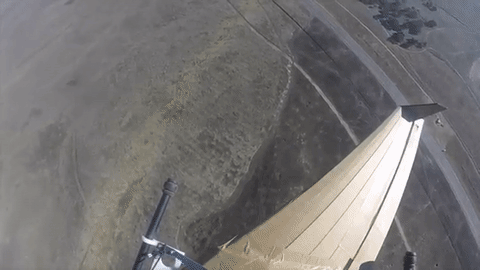These Paper Drones Are Built for One-Way Missions

Not many people would sign up for a one-way mission—thank goodness there are now drones to do the job for us.
Under a grant from DARPA, San Francisco-based Otherlab has built prototype drones out of cardboard that are designed to airdrop things like medicine, batteries, and communication devices into dangerous or hard-to-reach places.
The gliders are pre-programmed with their landing destination, then launched from a cargo plane or other aircraft (in tests, one was launched from a bigger drone). A small electronics package then steers each craft to its target. But with no motors and no need of a battery or fuel, they are meant to have as much room as possible for payload.
Drones have already delivered packages to paying Amazon customers and medicine to remote parts of Rwanda. The Department of Defense, too, is testing out drone swarms for a range of possible missions. But the idea of completely disposable, disintegrating drones is novel. On DARPA’s page for what it’s calling the ICARUS project, the agency states that it wants drones that “vanish into thin air” shortly after their missions are over.
To that end Otherlab’s Star Simpson, an engineer on the project, says that cardboard was only used to prove the design worked. The goal is to eventually make the drones’ bodies out of mycelium fibers—that is, mushrooms.
As Simpson told Air & Space, “Our preliminary work on that indicated that you can basically impregnate [mycelium] with different types of spores [which] are activated just before the vehicle is released.” The spores would grow and literally eat the drone, chewing through the body in about five or six days. As for the drone’s avionics, DARPA has a separate program funding the development of self-destructing electronics that would dovetail nicely.
Otherlab is no stranger to pursuing out-there ideas; it's been known to dabble in everything from renewable energy to inflatable robots. In a press release about the project, it suggests that a C-130 military transport plane could disperse hundreds of drones loaded with supplies across an area the size of California in a single flight.
So far, the Otherlab team has only tested models that are built to carry a payload of up to one kilogram, but Simpson says they could scale the design to make a drone with an eight-foot wingspan that can haul up to 10 kilograms.
(Read more: Air & Space, Recode, “A 100-Drone Swarm, Dropped from Jets, Plans Its Own Moves,” “Drones Set to Deliver Medicine to Remote Parts of the U.S.,” “An Amazon Drone Has Delivered Its First Products to a Paying Customer”)
Keep Reading
Most Popular
Large language models can do jaw-dropping things. But nobody knows exactly why.
And that's a problem. Figuring it out is one of the biggest scientific puzzles of our time and a crucial step towards controlling more powerful future models.
The problem with plug-in hybrids? Their drivers.
Plug-in hybrids are often sold as a transition to EVs, but new data from Europe shows we’re still underestimating the emissions they produce.
Google DeepMind’s new generative model makes Super Mario–like games from scratch
Genie learns how to control games by watching hours and hours of video. It could help train next-gen robots too.
How scientists traced a mysterious covid case back to six toilets
When wastewater surveillance turns into a hunt for a single infected individual, the ethics get tricky.
Stay connected
Get the latest updates from
MIT Technology Review
Discover special offers, top stories, upcoming events, and more.